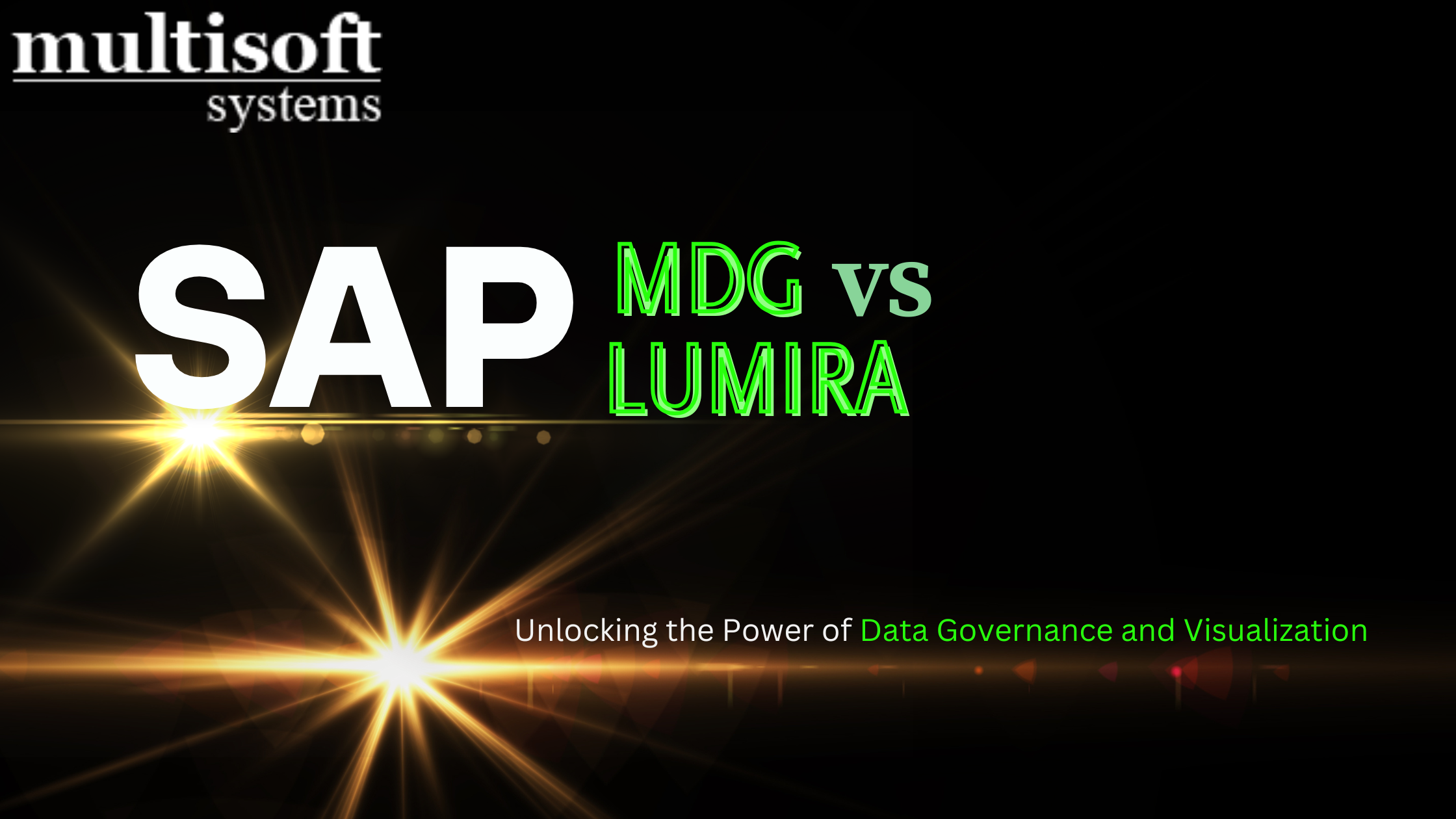
In the expansive SAP ecosystem, businesses often face a crucial decision when it comes to choosing the right tools for data management and visualization. Among the vast array of SAP offerings, SAP Master Data Governance (MDG) and SAP Lumira are two standout solutions — each serving a distinct purpose. While MDG focuses on master data consistency and governance, SAP Lumira emphasizes data visualization and self-service business intelligence.
Understanding the differences, strengths, and use cases of these tools is essential for organizations aiming to streamline their operations and make informed decisions. This article by Multisoft Systems offers a detailed comparison between SAP MDG training and SAP Lumira training, providing insights into their architecture, functionalities, integration capabilities, and value propositions.
Understanding SAP Master Data Governance (MDG)
SAP MDG is a centralized solution designed to manage and govern an organization’s master data. Master data refers to core business entities such as customers, suppliers, products, and financial hierarchies — foundational data used across various departments and business processes.
Key Features of SAP MDG
- Centralized Data Governance: It provides a single point of truth for master data across all systems.
- Data Quality Management: Built-in tools for data validation, standardization, duplicate checks, and enrichment.
- Workflow-Driven Processes: Customizable workflows to manage approvals and ensure compliance.
- Data Replication: Synchronizes master data across different SAP and non-SAP systems.
- Domain-Specific Governance: Includes pre-configured models for materials, business partners, financials, etc.
- Audit and Compliance: Comprehensive logs and change histories to support regulatory compliance.
Benefits of SAP MDG
- Enhanced data consistency and quality
- Reduced operational risks due to inaccurate data
- Increased productivity with automated workflows
- Better compliance and traceability
- Supports both central and co-deployment models
Understanding SAP Lumira
SAP Lumira is a data visualization and business intelligence tool that empowers business users to access, visualize, and analyze data in a user-friendly manner. It supports self-service BI, allowing users to create dashboards, charts, and interactive reports without needing extensive technical knowledge.
Key Features of SAP Lumira
- Self-Service Data Discovery: Business users can acquire, manipulate, and visualize data independently.
- Advanced Visualization: Offers a wide range of interactive visualizations like maps, graphs, and heatmaps.
- Integration with SAP HANA: Native integration allows fast in-memory processing for large datasets.
- Customizable Dashboards: Users can design reports using drag-and-drop features.
- Data Merging and Cleansing: Combine data from various sources and clean inconsistencies for better insights.
- Publishing and Sharing: Reports and dashboards can be shared across teams and embedded into other applications.
Benefits of SAP Lumira
- Empowerment of business users through self-service BI
- Faster decision-making via real-time insights
- Reduced dependency on IT teams for report creation
- Enhanced collaboration through shared dashboards
- Seamless integration with SAP and third-party data sources
SAP MDG vs SAP Lumira: Key Differences
|
Criteria |
|
|
||||||
|
Purpose |
|
|
||||||
|
|
|
||||||
|
|
|
||||||
|
|
|
||||||
|
|
|
||||||
|
Output |
|
|
||||||
|
Integration |
|
|
||||||
|
|
|
||||||
|
|
|
||||||
|
|
Custom charts and scripting available |
Use Case Scenarios
When to Use SAP MDG?
- Centralized Data Management: Organizations struggling with inconsistent customer or vendor records.
- Regulatory Compliance: Businesses in heavily regulated industries like pharma, banking, and insurance.
- SAP S/4HANA Migrations: Ensuring clean master data before system upgrades or transformations.
- Multi-System Environments: Enterprises operating multiple SAP or hybrid environments needing a centralized master data system.
When to Use SAP Lumira?
- Sales & Marketing Dashboards: Visualizing KPIs, customer trends, and campaign performance.
- Financial Analytics: Dynamic dashboards for revenue, expenses, and profitability.
- Operational Reporting: Real-time visualization of production, logistics, or procurement data.
- Executive Dashboards: High-level overviews to support strategic decision-making.
Synergy Between SAP MDG and SAP Lumira
The synergy between SAP Master Data Governance (MDG) and SAP Lumira lies in their complementary roles within an organization’s data strategy. SAP MDG ensures data integrity, consistency, and compliance by governing master data across systems, while SAP Lumira certification transforms this clean, reliable data into meaningful visual insights. When used together, they enable businesses to make accurate, data-driven decisions based on trusted information. High-quality master data from MDG enhances the effectiveness of Lumira’s analytics and visualizations, reducing errors and improving strategic planning. This integration supports a seamless flow from data governance to business intelligence, empowering smarter and faster decision-making.
SAP MDG and SAP Lumira in the SAP Intelligent Enterprise
In the SAP Intelligent Enterprise framework, SAP Master Data Governance (MDG) and SAP Lumira play pivotal yet distinct roles in driving data excellence and business agility. SAP MDG certification ensures a “single source of truth” by centralizing, standardizing, and governing master data across all systems, which is foundational to enabling intelligent processes. It aligns with SAP’s vision of a clean digital core, ensuring that enterprise applications run on accurate and consistent data. SAP Lumira, on the other hand, empowers business users to explore and visualize this governed data in real-time, delivering actionable insights through interactive dashboards and visual storytelling. By leveraging MDG’s trusted data as input, Lumira enhances decision-making across business functions with speed and clarity. Together, they help organizations transition into truly intelligent enterprises—where data integrity, governance, and analytics work hand in hand to support innovation, efficiency, and strategic growth in a competitive digital economy.
Challenges and Considerations
SAP MDG
- Requires careful planning, data modeling, and workflow configuration.
- Higher upfront cost; typically used by medium to large enterprises.
- Requires involvement from both IT and business users to be effective.
SAP Lumira
- While user-friendly, advanced features may require technical understanding.
- With greater access, organizations must ensure users have proper access controls.
- SAP has transitioned to SAP Analytics Cloud (SAC) as its go-to BI solution, making Lumira less of a future-focused tool.
Future Outlook: MDG and the Rise of SAP Analytics Cloud
While SAP MDG online training continues to evolve and integrate seamlessly with SAP S/4HANA, SAP Lumira's future is less certain. SAP is shifting its analytics strategy towards SAP Analytics Cloud (SAC), which combines BI, planning, and predictive analytics in a single solution.
However, many organizations still use SAP Lumira online training for its on-premise flexibility and familiar interface. The strategic shift underscores the importance of aligning with SAP’s roadmap when planning long-term analytics strategies.
Conclusion
SAP Master Data Governance (MDG) and SAP Lumira address different but equally critical aspects of enterprise data management. MDG ensures that your data foundation is clean, governed, and compliant. In contrast, SAP Lumira helps transform that data into actionable insights through compelling visualizations. For organizations aiming to become truly data-driven, combining robust data governance (MDG) with intuitive analytics tools (like Lumira or its successor SAC) is not just beneficial — it's essential.
Ultimately, a hybrid approach — where SAP MDG manages the data and SAP Lumira/SAC visualizes it — delivers the most value in a modern digital enterprise.
Enroll in Multisoft Systems now!



